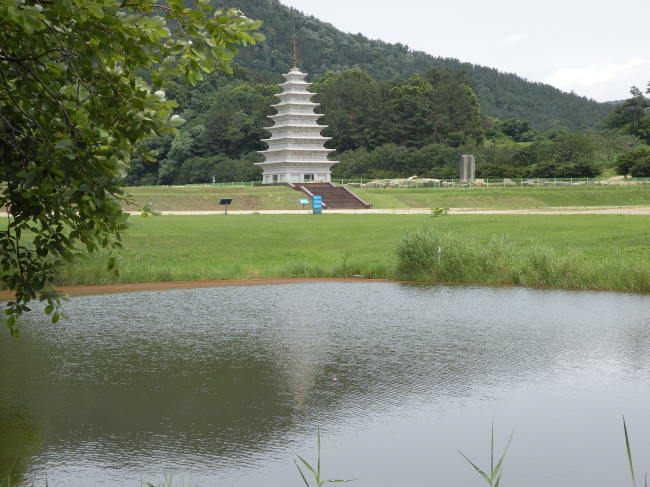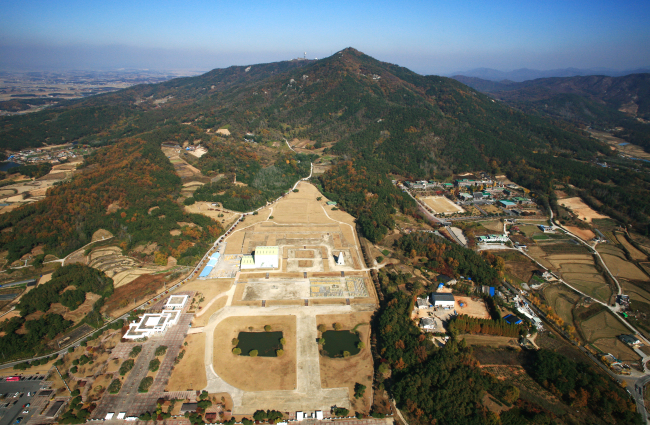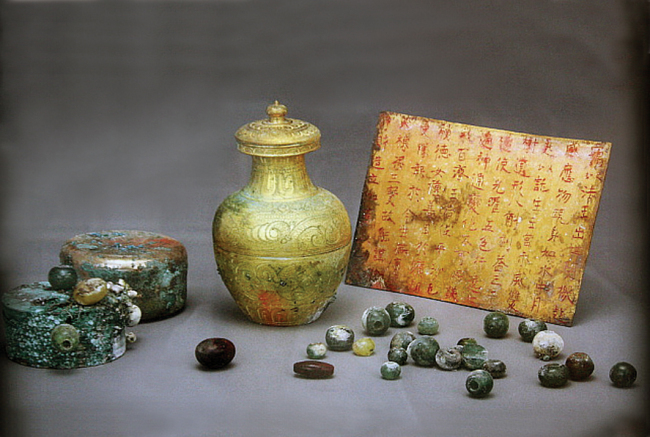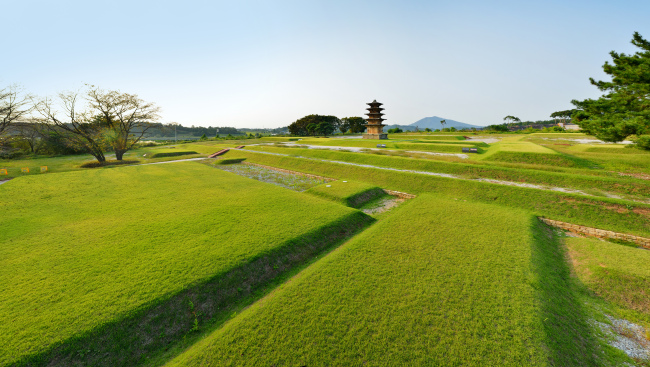Time travel to ancient kingdom of Baekje
Two UNESCO Heritage sites in Iksan show glamour, glory of old Korean kingdom whose influence reached to Japan and Southeast Asia
By 이우영Published : Aug. 26, 2015 - 17:27
IKSAN, North Jeolla Province -– A restoration project of the oldest stone pagoda in Korean history is underway at the site of Mireuksa Temple in Iksan, North Jeolla Province.
A rhythmic, clear sound of carving stone echoes through the vast site. Inside a temporary tent, stonemasons crack and sculpt stones that will become the new columns for the six-story pagoda.
The sound accompanies visitors everywhere in the new UNESCO’s World Heritage site, as no buildings block the sound’s spread. The east pagoda stands alone in its brand new stone columns put together in 1993.
A rhythmic, clear sound of carving stone echoes through the vast site. Inside a temporary tent, stonemasons crack and sculpt stones that will become the new columns for the six-story pagoda.
The sound accompanies visitors everywhere in the new UNESCO’s World Heritage site, as no buildings block the sound’s spread. The east pagoda stands alone in its brand new stone columns put together in 1993.

On this vast, empty site once stood a huge Buddhist temple from Baekje, known to be the biggest in East Asia. It is one of the eight historical sites of the B.C.18 -A.D. 660 Baekje Kingdom added to UNESCO’s World Heritage list in July. The eight -- royal palaces, fortresses and tombs representing later periods of Baekje -- are scattered across the three cities of Gongju, Buyeo and Iksan.
Built in 639 A.D., the Mireuksa temple was a symbol of spiritual guidance and support for Baekje in its final years amid growing threats from neighboring kingdoms. Baekje came to an end 21 years later when it was defeated by the alliance of Silla Kingdom and the Tang Dynasty of China.
One can guess the scale of the temple by walking from the entrance to the foot of Mount Mireuksan in the back. In this vast site, two tranquil ponds are located near the entrance to offer shade from the blazing summer sun.

There used to be three pagodas -- east and west stone pagodas and a wooden pagoda in the middle. The west pagoda, initially built as nine stories, lost three of them as time passed. During the Japanese colonial period, it was shabbily repaired by the Japanese who covered the back of the pagoda with cement to prevent its collapse.
When the west pagoda was disassembled for restoration in 2009, sacred sariras were found in the central stone column of the pagoda. The sariras, which resemble fragments of clear violet and white quartz, and its exquisite golden container incite both veneration and awe from viewers. They are on exhibit at the Mireuksaji Relics Exhibition Museum, adjacent to the temple site, until Dec. 31.

A nice way to complete the tour after a long walk around the site is trying soft tofu dishes at restaurants near Mount Mireuksan.
“The area near Mount Mireuksan and the temple site is also popular for soft tofu restaurants. After a long hike in Mount Mireuksan, having soft tofu is almost like a ritual for local people,” said Choi Bo-min, an official of the cultural heritage division of Iksan City Government, who has been living in Iksan for 20 years.
Another new UNESCO World Heritage site is located 5 kilometers from Mireuksa Temple site. The old Baekje palace site in Wanggung-ri epitomizes the kingdom’s dream to revive its old glamour and glory that spanned 700 years.
The site, however, is an empty field covered in green grass. It’s hard to find physical structures that show the glory of the old kingdom, aside from the five-story stone pagoda standing alone in this vast archaeological site.

For centuries, the area has been called Wanggung-ri, meaning “town of the king’s palace,” as people believed the area was a royal palace site from the Three Kingdoms period. The excavation effort, which began in 1976, found that a royal palace of Baekje from the mid-seventh century was established here.
Last week, kitchen sites were discovered in the palace site, along with a public toilet. The palace had a separate kitchen building and toilet. In the kitchen site, iron caldrons, jars and pots were excavated.
“These findings are great evidence that helps us know what an ancient kitchen looked like,” said Bae Yeong-seon, director of the Buyeo National Research Institute of Cultural Heritage, during a press preview of the site last week.
“It’s the earliest form of kitchen ever found in Korea.”
A public toilet was located separately from the main palace building as well. The toilet spot was dug deep and had stepping stones. Sticks found here were used as toilet paper.
Local people say the cherry blossom season in spring is the best time to visit the site. The cherry blossom scene around the Wanggung-ri stone pagoda is considered one of the best in the country.
The Wanggung-ri Palace site is left with nothing but a beautiful scenery as majority of relics discovered here were moved outside the city. Most of them are at the Jeonju National Museum in Jeonju, located 27 kilometers from Iksan. Iksan has no national museum to house its artifacts yet.
Iksan city government runs a cultural walk that visits major historical spots including Wanggung-ri Palace site and Mireuksa Temple site once in every month. The upcoming event is scheduled to be held on Sept. 19. For more information, visit wg.iksan.go.kr.
The city also runs city tour buses Saturdays on the second and fourth week of every month from March to November. For more information, call (063) 859-7755.
By Lee Woo-young (wylee@heraldcorp.com)


















![[Today’s K-pop] Treasure to publish magazine for debut anniversary](http://res.heraldm.com/phpwas/restmb_idxmake.php?idx=642&simg=/content/image/2024/07/26/20240726050551_0.jpg&u=)